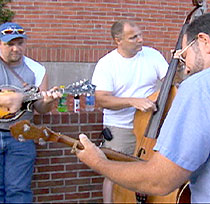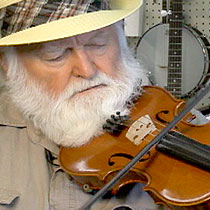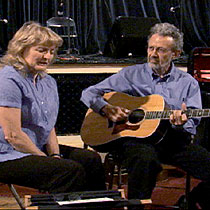-
(单词翻译:双击或拖选)
Washington
12 July 2007
American country music - in its various forms - has grown into a multi-million dollar industry with fans around the world. As an art form, it has crossed over into the mainstream1 of U.S. culture. But, for all the commercial success of the present day, its origins were humble2. Those roots are still very much alive, as Malcolm Brown reports from West Virginia.
 |
| Appalachian jam session |
The town of Glenville has hosted this event since its inception4 in 1950, as a way to preserve and celebrate the region's traditional culture.
Besides the bands, entertainment includes square dancing and the chance for everyone to play in jam sessions, which form in a motel parking lot.
Traditional instruments, like dulcimers, can be heard well into the night as complete strangers and old friends play together.
 |
| Charles Salisbury |
West Virginia is in Appalachia - a mountainous eastern region, settled in the 18th century by immigrants from Europe, many of them from Scotland, Ireland and England. Along with the settlers came their culture.
Well-known fiddler Joe Dobbs says Old World tunes9 survived in the mountains of Appalachia and were handed down from generation to generation.
 |
| Joe Dobbs |
Instruments on the walls of his music store reflect the various influences, which blended to create the Appalachian sound. They include the Irish fiddle -- and the banjo, which came with the slaves brought over from Africa.
Naturally, the immigrants also brought their singing traditions - especially ballads10. Over time in Appalachia, a style evolved. Singer Ginny Hawker, who plays with husband Tracy Schwarz, calls it a "lonesome mountain sound." "It attracts people because it's real music. It's about real thing and about life close to the bone and I think those things have a universal appeal. So, I don't see it dying out."
 |
| Ginny Hawker and Tracy Schwarz |
Joe Dobbs says the region acted as a cultural reservoir, from which the traditional sounds could be re-exported during the folk revival13 of the 1950s and 60s. "For some reason, these people stayed in these mountains and they kept playing the tunes and still do, especially after the folk revival. It's more popular now than ever."
The evident youth of some players at the folk festival suggests that Appalachian music does indeed have a future.
 收听单词发音
收听单词发音
1
mainstream

|
|
| n.(思想或行为的)主流;adj.主流的 | |
参考例句: |
|
|
|
2
humble

|
|
| adj.谦卑的,恭顺的;地位低下的;v.降低,贬低 | |
参考例句: |
|
|
|
3
venues

|
|
| n.聚集地点( venue的名词复数 );会场;(尤指)体育比赛场所;犯罪地点 | |
参考例句: |
|
|
|
4
inception

|
|
| n.开端,开始,取得学位 | |
参考例句: |
|
|
|
5
fabric

|
|
| n.织物,织品,布;构造,结构,组织 | |
参考例句: |
|
|
|
6
gatherings

|
|
| 聚集( gathering的名词复数 ); 收集; 采集; 搜集 | |
参考例句: |
|
|
|
7
fiddle

|
|
| n.小提琴;vi.拉提琴;不停拨弄,乱动 | |
参考例句: |
|
|
|
8
tune

|
|
| n.调子;和谐,协调;v.调音,调节,调整 | |
参考例句: |
|
|
|
9
tunes

|
|
| n.曲调,曲子( tune的名词复数 )v.调音( tune的第三人称单数 );调整;(给收音机、电视等)调谐;使协调 | |
参考例句: |
|
|
|
10
ballads

|
|
| 民歌,民谣,特别指叙述故事的歌( ballad的名词复数 ); 讴 | |
参考例句: |
|
|
|
11
aficionados

|
|
| n.酷爱…者,…迷( aficionado的名词复数 ); 爱看斗牛的人 | |
参考例句: |
|
|
|
12
isolation

|
|
| n.隔离,孤立,分解,分离 | |
参考例句: |
|
|
|
13
revival

|
|
| n.复兴,复苏,(精力、活力等的)重振 | |
参考例句: |
|
|
|















